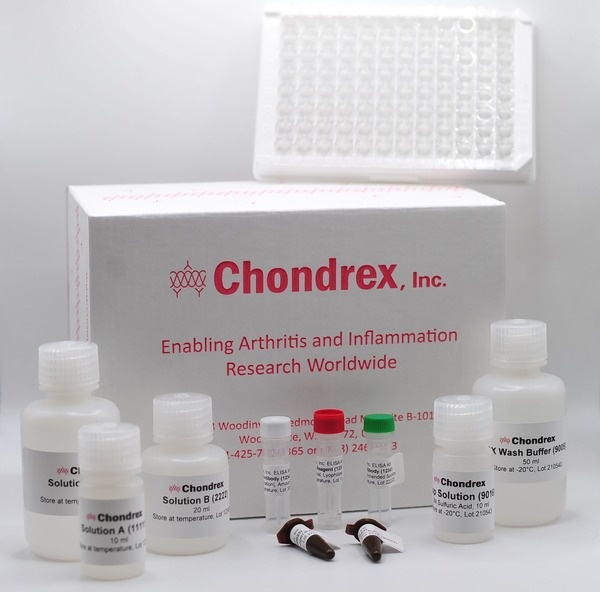High-Mobility Group Box 1 (HMGB1, also known as amphoterin) was recently rediscovered as a late stage lethal mediator of endotoxin, and is now considered as a pro-inflammatory cytokine with crucial roles in a variety of acute and chronic inflammatory diseases. Chondrex, Inc. provides native HMGB1 purified from bovine thymus, as well as a HMGB1 detection kit designed to assay HMGB1 levels in cell culture media and mouse sera, and anti-HMGB1 antibodies.
HMGB1 and HMGB1 Detection Kit
| Product | Catalog # | Price (USD) | |
|---|---|---|---|
 |
Bovine HMGB1 | 9050 | 241.00 |
 |
HMGB1 Detection Kit | 6010 | 528.00 |
HMGB1
Chondrex, Inc. manufactures HMGB1 purified from bovine thymus by ammonium sulfate fractionation followed by ion-exchange chromatography. This product is suitable for testing the biological and pathological functions of HMGB1 for in vitro and in vivo experiments.
HMGB1 is one of three nuclear mammalian HMG protein families (HMGB1/2, HMGB14/17, and HMGBI/Y) and is closely related to HMGB2, which is often co-localized in cells and shares 80% sequence homology. HMGB1 shares 100% amino acid sequence identity between mice and rats, and 99% between rodents, bovines and humans. HMGB1 is a negatively charged protein with 219 amino acid residues (predicted MW: 25KDa) and determined as 30KDa by SDS-PAGE analysis. HMGB1 consists of three structural domains: two DNA-binding motifs termed “A box (9-85)” and “B box (88-162)” that form 3 alpha helices, and a carboxyl terminus (186-216) that is rich in negatively charged aspartic acid and glutamic acid termed the “acidic tail”. The amino terminus is also unique and rich in positively charged lysine. It is also reported that the B box recapitulates the pro-inflammatory activity whereas the A box acts as an antagonist of HMGB1.

HMGB1 Detection Kit
HMGB1 is actively released by a variety of cells such as macrophages, monocytes, and pituicytes stimulated by LPS, and is passively released by injured or necrotic cells associated with collapsing cell structures. Importantly, HMGB1 induces the secretion of other inflammatory cytokines from cells, and may induce chemotaxis of cells via signal transduction by binding to cell surface receptors. The role of HMGB1 in inflammatory diseases may be explained by its dual functionality. HMGB1 can act directly by binding to the cells and induce signaling and chemotaxis, and indirectly by up-regulating the expression and secretion of pro-inflammatory cytokines. HMGB1 is secreted in a time and dose dependent manner in vitro by macrophages, monocytes and pituicytes exposed to LPS, TNF and IL-1. Interestingly, HMGB1 itself stimulates the release of TNF and IL-1. These observations indicate that HMGB1 plays important roles in sepsis but also in the early to middle stage of inflammatory cascades. In fact, high serum HMGB1 levels were observed in patients with septic and hemorrhagic shock, and importantly, HMGB1 levels were lower in patients that survived sepsis than those that died from sepsis. Similarly, high serum HMGB1 levels are observed in sepsis models and in collagen-induced arthritis models.
Chondrex, Inc. provides a capture ELISA kit to determine HMGB1 levels in cell culture medium and mouse sera. This kit contains enough reagents to measure 40 samples in duplicate together with standards.
Technical specifications of Chondrex, Inc.'s HMGB1 Detection Kit
| Standard Range: | 1 - 100 ng/ml |
| Reproducibility: | Intra-assay coefficient of variation is less than 4.2% |
| Inter-assay coefficient of variation is less than 7.6% | |
| Recovery: | Recovery of mouse serum samples is 87 - 137% |
| Specificity: | Cross-reactivity with bovine HMGB2 is 12.4% |